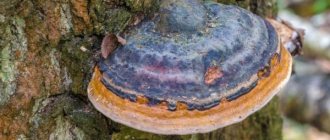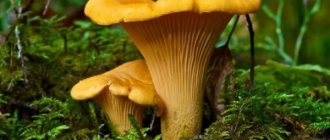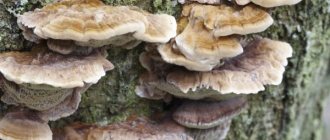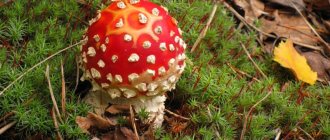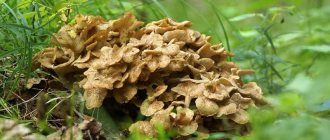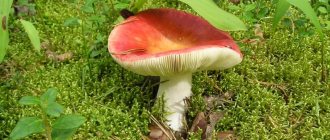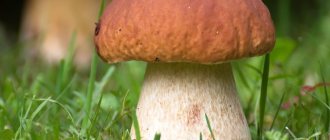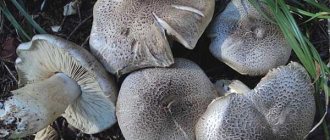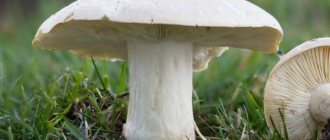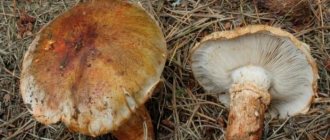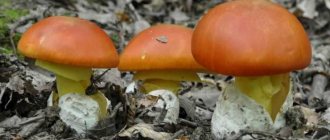Short description
| Type of mushrooms: | conditionally edible |
| Other names (synonyms): | Gyroporus chestnut, Chestnut mushroom, hare mushroom |
| Latin name: | Gyroporus castaneus |
| Family: | Gyroporaceae |
| Distinctive feature: | Gyroporus chestnut - most likely received this name because of its chestnut color. These are one of the favorite delicacies of forest dwellers. |
| Beginning of the season: | July |
| End of season: | September |
| Leg height (cm): | 3-6 cm |
| Cap width (cm): | 2.5-5 (10) cm |
| Smell: | sourish |
| Taste: | not expressed |
| Tasting score: | Have you tried this mushroom? Then rate it! |
| Hat: | in youth hemispherical, later convex, cushion-shaped. Color ranges from yellow-brown to brown, dull. The skin is smooth, the edges are sharp. |
| Leg: | conical, slightly separated from the cap, smooth. Same color as the hat. |
| Hymenophore (bottom of cap): | has a porous surface: initially white to cream, becoming dull yellow. |
| Disputes: | elliptical, smooth, 8.7-12 x 5-7 microns. |
| Pulp: | hard, whitish. |
| Natural environment and mycorrhiza: | in deciduous and coniferous forests. |
| False doubles: | Gyroporus is blue - has a hollow stalk, but turns blue at the break. |
| Growing: | – |
| Use: | Suitable only for drying, as it acquires a bitter taste when cooked. |
| Medicinal properties: | – |
| Spreading: | Europe, North America. |
The chestnut mushroom is a little-known edible species that is little known to a wide range of lovers of quiet hunting and has high taste qualities. Other names: hare mushroom, sand mushroom, Gyroporus chestnut, chestnut mushroom, Gyroporus chestnut, hare's tail. Latin name: Gyroporus castaneus.
Description of the mushroom
Chestnut mushroom is a tubular, cap mushroom. Belongs to the Boletaceae family, genus Giroporus. Sizes are larger than average.
It is called chestnut because it prefers to grow near broad-leaved trees, which include chestnut, beech and oak, and also has a color similar to the color of these trees. The name “hare mushroom” stuck because of the love of these animals to taste it.
Chestnut often grows in symbiosis with trees, but can do without them.
hat
It has a convex shape, can have different shades of brown, turning into red or light brown. Velvety, dry or smooth to the touch. Old specimens have less villi on the cap than young ones. It may become covered with cracks - this directly depends on weather conditions. The edges of the cap are turned up, showing the hymenophore of this species.
Hymenophore
The tubes in the lower part are white, yellowish or cream in color. A yellow tint indicates that the chestnut tree is ripe. If you press, the color will change to dark brown. Over time, the tubular layer becomes loose and easily lags behind the stem. The tubes contain light yellow small round spores.
Pulp
Chestnut has fleshy white flesh, which subsequently darkens. When broken, the color does not change. In mature mushrooms it is more fragile, in old ones it is hard and dry.
Leg
It has a cylindrical shape, slightly thickening towards the bottom. Its length can be no more than 8 cm, and the color is similar to the color of the cap. Slightly flattened on the sides. The stem changes with the age of the mushroom: at first it looks like cotton wool, but as it ages, it becomes empty inside.
The stem of this species has a peculiarity - when you cut the mushroom, you cannot see the darkening on it, which is characteristic of many other representatives of the mushroom kingdom. The cut remains the same color.
Time and place of fruiting
It can bear fruit alone or in groups. Prefers sandy soil and light areas for growth. In a dense forest where the sun's rays do not reach, chestnut trees cannot be found. The first mushrooms begin to appear in July, their active growth occurs in August. This species has the right to be called an autumn species, since it bears fruit well until the first frost.
The fungus is widespread but rare. The decline in its numbers is affected by the disturbance of natural habitats due to deforestation and trampling. The quiet hunt for this species does not pass without a trace.
In Russia it is usually found in the south of the European part, in the Caucasus, Western Siberia and the Far East. In the Ryazan region it grows in the Spassky and Kasimovsky districts, in particular, near the villages of Aleshino and Samylovo.
Growing Sparassis on tree trunks
If you have a suitable plot of land, for example, in a garden, in a greenhouse, or even in a specially designated plot of vegetable garden, hare cabbage can also be grown on solid logs of wood. This method is good because it does not require the hassle of regularly replacing the substrate, since on solid wood the mycelium will grow for several years in a row, rather than one or two seasons.
As in the case of sawdust for sparassis, you need to choose coniferous tree trunks. The size of the barrel is determined only by issues of convenience. If desired, you can use either a huge log ten meters long and 30 centimeters in diameter, or small cuts several tens of centimeters long.
It is highly desirable that the wood be freshly cut or have a short shelf life. This not only eliminates the possibility of infection by competitive species, but also eliminates the need for additional moisture. In addition, sparassis, in principle, prefers fresh “food” to dry and stale food.
In the trunk, cuts are made with a drill in increments of 10-15 cm, which are then inoculated with mycelium and sealed with the same sawdust. The trunk is then placed in a shady part of the garden or in a greenhouse so that it is in contact with the ground along its entire length and does not sag anywhere. This eliminates the possibility of the wood drying out: it itself will draw moisture directly from the soil.
False doubles
The chestnut mushroom is not similar to its poisonous “relatives”, but is similar to some inedible ones.
The gall fungus can confuse lovers of quiet hunting. Outwardly it looks like chestnut, is not poisonous, but has a bitter taste.
The gall fungus belongs to the Tilopilaceae genus and the Boletaceae family. It bears fruit in the same period as the chestnut tree. Found on sandy soils, mixed and coniferous forests.
Bile mushroom
The average size of the cap is about 12 cm, the shape is convex. Coloring – in brown, brown tones. The mushroom has white flesh that is soft to the touch and grows up to 10 cm. Unlike chestnut, the cut changes color, becoming pink.
The leg reaches 3.5 cm in diameter and is dotted with a grid pattern. Its color is beige, different from chestnut. The aroma is weak, the taste of the gall mushroom is more bitter than that of the chestnut mushroom. It can be cooked, but it is very difficult to overcome the bitter taste, even by soaking it in salt water.
Hyroporus blue is another species that is similar to the chestnut one. The mushroom is also edible and rare; it prefers to grow in bright places, on the edges, in the same place as the chestnut mushroom. The cap is velvety and yellow-brown, the leg is white.
Gyroporus blue
When broken or cut, the damaged part becomes blue in color; purple shades are less common.
Sometimes the chestnut mushroom is confused with the satanic one. Eating this species in significant quantities and without proper processing can lead to serious health problems. In many countries it is allowed for collection and consumption.
The main difference from other similar species, in particular from chestnut, is the reddish leg. The dense, white flesh turns blue when cut.
Evaluation of taste qualities, medicinal properties, benefits and contraindications
Chestnut is an edible species and has a pleasant taste. It belongs to the second category of mushrooms, that is, it is valuable and nutritious, but is inferior in taste to representatives of the first category.
Kashtanova has a wide range of medicinal properties. The chemical composition contains fiber, vitamins, minerals and natural protein, which makes it very valuable.
Positive properties:
- Stabilizes the state of the nervous system.
- Normalizes blood pressure.
- Increases immunity.
- Reduces weight.
- Helps in the fight against cancerous tumors.
Preparations created on the basis of chestnut mushrooms can alleviate the condition of a person suffering from cerebral vascular spasms. Based on this species, medications have been developed to help with epilepsy.
Chestnut fruit has a bitter taste for a reason. It has this feature due to the toxic substances it contains. Because of them, problems with the liver and gastrointestinal tract may occur. Symptoms usually appear within 24 hours.
REFERENCE! To avoid such consequences of eating chestnut mushrooms, it is necessary to follow safety rules when picking mushrooms, and also be careful about the method of their preparation and processing.
How to avoid getting skin cancer? What to avoid?
Sunlight. The most proven cause of both types of skin cancer, as well as melanoma, is exposure to sunlight. If you like to travel to hot countries, have fair hair and skin, or your work involves prolonged exposure to the sun, you should seriously consider UV protection.
Precancerous skin diseases are the next factor that may precede the development of the squamous cell form: actinic (solar) keratoses and cheilitis, leukoplakia, human papillomavirus infection of the mucous membranes and genitals. This type of tumor can also develop against the background of scar changes after burns or radiation therapy.
Contact with carcinogens
Various chemicals can lead to the development of skin cancer: arsenic and petroleum products.
Weakened immune system. People taking immunosuppressive drugs after an organ transplant or people living with HIV have an increased risk of developing squamous cell skin cancer.
Cooking recipes
This mushroom should not be marinated. The brine will contain bitterness, which can ruin the taste of the entire dish. The same applies to salting chestnut trees.
Cleaning
Mushrooms brought from the forest must be subjected to some kind of processing as quickly as possible, since they quickly deteriorate. As a last resort, leave them in the refrigerator for a few hours before cleaning:
- Cut off the mycelium - the lower part of the leg.
- Clean the fruit body from dirt.
- Rinse the mushrooms well and soak for 20 minutes.
- After all the manipulations, the chestnut trees can be subjected to further processing.
Frying
Chestnut mushroom can be fried, but should not be boiled, since in this form it will certainly taste bitter.
Preparation:
- For frying, use washed mushrooms.
- After boiling in salted water, place the product in a colander and let the liquid drain.
- Grease a heated frying pan with oil and place the chopped fruit bodies on it.
- They will fry for 10-15 minutes. You need to constantly stir the contents of the pan.
You can also fry chestnuts with vegetables. In this case, the vegetables are first fried, and then the mushrooms are added to the pan.
Drying
When dried, the chestnut tree loses its bitter taste, so it is subjected to this type of processing.
Drying has a number of advantages:
- Mushrooms remain edible longer.
- They are more nutritious than pickled or salted ones.
- Nutritional benefits are maintained.
Preparation for drying:
- Clean the fruiting bodies thoroughly.
- It is not recommended to wash mushrooms before drying; it is enough to clean them thoroughly from dirt and wipe them.
- You should choose intact specimens, which are cut into plates or cubes.
- It is important to dry the fungi to the desired extent. If you overdry, they will lose their taste and aroma. If they are under-dried, they will not be stored for long and will begin to mold and deteriorate. A quality product should bend easily, but not break.
Note! If the mushrooms are still dry, you can grind them and make a powder. When combined with salt and herbs, you get an excellent spice that is easy to store.
To dry in the oven:
- Separate the stems from the caps.
- Cut into medium pieces.
- Place on a wire rack, which must first be placed on a baking sheet.
- Heat the oven to 40-60 degrees.
- Open the oven door to evaporate excess moisture.
- Leave for 48 hours.
Chestnuts can dry unevenly, so you should remove fully finished specimens from the oven in a timely manner.
Another drying method involves using a microwave:
- Peel and chop the mushrooms.
- Place on a plate and place in the microwave at 100-180 W.
- After 15-20 minutes, open the microwave cabinet for ventilation, and then turn it on again for 15-20 minutes.
- The number of such repetitions depends on the thickness of the sliced mushrooms. On average, 4 stages of 20 minutes are enough.
You can also use the long-known drying method. Whole or coarsely chopped mushrooms are strung on a nylon thread. Suspended in areas protected from rain.
It is advisable to cover them with a cloth to prevent dust from settling. During the drying process, chestnut trees absorb all surrounding odors, so you should choose well-ventilated areas.
Growing Sparassis on sawdust
Like most edible mushrooms that grow on wood, hare cabbage is relatively easy to cultivate. In general, the technology is approximately the same as in the case of oyster mushrooms, but you need to take sawdust not from deciduous wood, but from coniferous wood. As mentioned above, this mushroom prefers pine, spruce, cedar, fir and larch.
To prepare the nutrient substrate, it is recommended to use the freshest sawdust possible. And of course, they should not contain any traces of chemicals used to treat wood to combat insects and pathogens.
To improve the nutritional quality of sawdust and obtain a finished substrate, they are mixed with a small amount of hay, bran, gypsum and a combined mineral additive. Next, it is very important to get rid of competing microorganisms present in the substrate. For this purpose, sawdust with additives added to it must be filled with water, brought to a boil and then boiled for 1-2 hours.
When the solution has cooled, drain the water and place the substrate on a fine mesh to drain excess water. The optimal sawdust moisture level is 70%. This indicator occurs after approximately 10-14 hours of drying on the mesh. Determining the readiness of sawdust is quite simple: they should be damp to the touch, but should not stick to your hands.
The substrate, freed from excess moisture, is placed in a plastic bag in layers of 5 cm, sprinkling each layer with crushed mycelium. Then the bag must be tied tightly. Over time, the mycelium will germinate and entangle the entire substrate with a thick network, turning it into a monolithic block. When this happens, you need to carefully cut small holes (2 by 2 cm) in the bag through which the fruiting bodies will break through.
